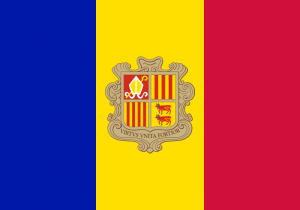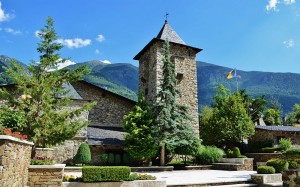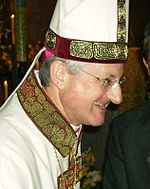Andorra

The Iberian Peninsula: Spain, Portugal, Andorra, and Gibraltar (1949)
The Iberian Peninsula (Asturian, Leonese, Mirandese, Spanish, Portuguese and Galician: Península Ibérica, Catalan: Península Ibèrica, Aragonese and Occitan: Peninsula Iberica, French: Péninsule Ibérique, Basque: Iberiar Penintsula), sometimes called Iberia, is located in the extreme southwest of Europe and includes the modern-day sovereign states of Spain, Portugal and Andorra, as well as the British Overseas Territory of Gibraltar. It is the westernmost of the three major southern European peninsulas — the Iberian, Italian, and Balkan peninsulas. It is bordered on the southeast and east by the Mediterranean Sea, and on the north, west and southwest by the Atlantic Ocean. The Pyrenees form the northeast edge of the peninsula, separating it from the rest of Europe. In the south, it approaches the northern coast of Africa. It is the second-largest peninsula in Europe, with an area of approximately 590,000 km2 (230,000 sq mi). The principal urban centres are: Madrid, Barcelona, Valencia, Seville, Zaragoza, Málaga, Lisbon, Murcia, Palma, Las Palmas de Gran Canaria, Bilbao, Alicante, Córdoba, Valladolid, Vigo, Vila Nova de Gaia, Gijón, L’Hospitalet de Llobregat, A Coruña, Porto, Vitoria-Gasteiz, Granada, Elche, Oviedo, Braga, Sintra, Coimbra and Setúbal. Various other notable cities are also present on the peninsula. The main metropolitan areas and conurbations over a million are: Madrid, Barcelona, Lisbon, Valencia, Porto, Seville, Bilbao and Málaga.
Andorra (![]() i/ænˈdɔrə/; Catalan pronunciation: [ənˈdorə], locally: [anˈdɔra]), officially the Principality of Andorra (Catalan: Principat d’Andorra), also called the Principality of the Valleys of Andorra (Catalan: Principat de les Valls d’Andorra), is a landlockedmicrostate in Southwestern Europe, located in the eastern Pyrenees mountains and bordered by Spain and France. It is the sixth smallest nation in Europe, having an area of 468 km2 (181 sq mi) and an estimated population of 85,000 in 2012. Its capital, Andorra la Vella, is the highest capital city in Europe, at an elevation of 1,023 metres (3,356 ft) above sea level. The official language is Catalan, although Spanish, Portuguese, and French are also commonly spoken.
i/ænˈdɔrə/; Catalan pronunciation: [ənˈdorə], locally: [anˈdɔra]), officially the Principality of Andorra (Catalan: Principat d’Andorra), also called the Principality of the Valleys of Andorra (Catalan: Principat de les Valls d’Andorra), is a landlockedmicrostate in Southwestern Europe, located in the eastern Pyrenees mountains and bordered by Spain and France. It is the sixth smallest nation in Europe, having an area of 468 km2 (181 sq mi) and an estimated population of 85,000 in 2012. Its capital, Andorra la Vella, is the highest capital city in Europe, at an elevation of 1,023 metres (3,356 ft) above sea level. The official language is Catalan, although Spanish, Portuguese, and French are also commonly spoken.
Created under a charter in AD 988, the present Principality was formed in 1278. It is known as a principality as it is a monarchy headed by two co-princes – the Spanish Bishop of Urgell and the President of France.
Andorra is a prosperous country mainly because of its tourism industry, which services an estimated 10.2 million visitors annually, and because of its status as atax haven, although it is in the process of reforming its tax regime. It is not a member of the European Union, but the euro is the de facto currency. The people of Andorra have the 7th highest human life expectancy at birth in the world – 82 years.
 Sant Joan de Caselles church, dating from the 11th century.
Sant Joan de Caselles church, dating from the 11th century.
Tradition holds that Charles the Great (Charlemagne) granted a charter to the Andorran people in return for fighting against the Moors. Overlordship of the territory was by the Count of Urgell and eventually by the bishop of the Diocese of Urgell. In 988, Borrell II, Count of Urgell, gave the Andorran valleys to the Diocese of Urgell in exchange for land inCerdanya. Since then the Bishop of Urgell, based in Seu d’Urgell, has owned Andorra.
Before 1095, Andorra did not have any type of military protection and the Bishop of Urgell, who knew that the Count of Urgell wanted to reclaim the Andorran valleys, asked for help and protection from the Lord of Caboet. In 1095, the Lord of Caboet and the Bishop of Urgell signed under oath a declaration of their co-sovereignty over Andorra. Arnalda, daughter of Arnau of Caboet, married the Viscount of Castellbò and both became Viscounts of Castellbò and Cerdanya. Years later their daughter, Ermessenda, married Roger Bernat II, the French Count of Foix. They became Roger Bernat II and Ermessenda I, Counts of Foix, Viscounts of Castellbò and Cerdanya, and co-sovereigns of Andorra (shared with the Bishop of Urgell).
In the 11th century, a dispute arose between the Bishop of Urgell and the Count of Foix. The conflict was resolved in 1278 with the mediation of Aragon by the signing of the first paréage which provided that Andorra’s sovereignty be shared between the count of Foix (whose title would ultimately transfer to the French head of state) and the Bishop of Urgell, in Catalonia. This gave the principality its territory and political form.
Over the years, the co-title to Andorra passed to the kings of Navarre. After Henry of Navarre became King Henry IV of France, he issued an edict in 1607 that established the head of the French state and the Bishop of Urgell as co-princes of Andorra. In 1812–13, the First French Empire annexed Catalonia and divided it in fourdépartements, with Andorra being made part of the district of Puigcerdà (département of Sègre).
20th Century
 Boris Skossyreff, briefly self-proclaimed “King of Andorra” in 1934.
Boris Skossyreff, briefly self-proclaimed “King of Andorra” in 1934.
Andorra declared war on Imperial Germany during World War I, but did not actually take part in the fighting. It remained in an official state of belligerency until 1939 as it was not included in the Treaty of Versailles.
In 1933, France occupied Andorra as a result of social unrest before elections. On July 12th 1934, adventurer Boris Skossyreff issued a proclamation in Urgell, declaring himself “Boris I, King of Andorra”, simultaneously declaring war on the Bishop of Urgell. He was arrested by Spanish authorities on 20 July and ultimately expelled from Spain. From 1936 to 1940, a French detachment was garrisoned in Andorra to prevent influences of the Spanish Civil War and Francoist Spain. Francoist troops reached the Andorran border in the later stages of the war. During World War II, Andorra remained neutral and was an important smuggling route between Vichy France and Spain.
Given its relative isolation, Andorra has existed outside the mainstream of European history, with few ties to countries other than France and Spain. In recent times, however, its thriving tourist industry along with developments in transport and communications have removed the country from its isolation. Its political system was modernized in 1993, when it became a member of the United Nations and the Council of Europe.
current Episcopal Co-Prince of Andorra since 12 May 2003.
current French co-prince of Andorra since 15 May 2012.
Andorra is a parliamentary co-principality with the President of France and the Bishop of Urgell (Catalonia, Spain), as co-princes. This peculiarity makes the President of France, in his capacity as Prince of Andorra, an elected reigning monarch, even though he is not elected by a popular vote of the Andorran people. The politics of Andorra take place in a framework of a parliamentary representative democracy, whereby the Head of Government is the chief executive, and of a pluriform multi-party system.
The current Head of Government is Antoni Martí of the Democrats for Andorra (DA). Executive power is exercised by the government. Legislative power is vested in both government and parliament.
The Parliament of Andorra is known as the General Council. The General Council consists of between 28 and 42 Councillors, as the members of the legislative branch are called. The Councillors serve for four-year terms and elections are held between the thirtieth and fortieth days following the dissolution of the previous Council. The Councillors can be elected on two equal constituencies.
Half are elected in equal number from each of the seven administrative parishes and the other half of the Councillors are elected from a single national constituency. 15 days after the election, the Councillors hold their inauguration. During this session, the Syndic General, who is the head of the General Council, and the Subsyndic General, his assistant, are elected. Eight days later, the Council convenes once more. During this session the Head of Government is chosen from among the Councillors.
 Casa de la Vall, Andorran Parliament
Casa de la Vall, Andorran Parliament
Candidates for the nomination can be proposed by a minimum of one-fifth of the Councillors. The Council then elects the candidate with the absolute majority of votes to be Head of Government. The Syndic General then notifies the Co-princes who in turn appoint the elected candidate as the Head of Government of Andorra. The General Council is also responsible for proposing and passing laws. Bills may be presented to the Council as Private Members’ Bills by three of the Local Parish Councils jointly or by at least one tenth of the citizens of Andorra.
The Council also approves the annual budget of the principality. The government must submit the proposed budget for parliamentary approval at least two months before the previous budget expires. If the budget is not approved by the first day of the next year, the previous budget is extended until a new one is approved. Once any bill is approved, the Syndic General is responsible for presenting it to the Co-princes so that they may sign and enact it.
If the Head of Government is not satisfied with the Council, he may request that the Co-princes dissolve the Council and order new elections. In turn, the Councillors have the power to remove the Head of Government from office. After a motion of censure is approved by at least one-fifth of the Councillors, the Council will vote and if it receives the absolute majority of votes, the Head of Government is removed.
http://en.wikipedia.org/wiki/Andorra




